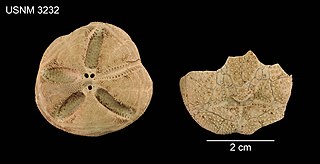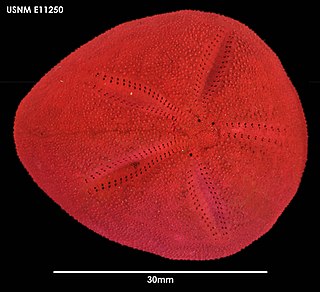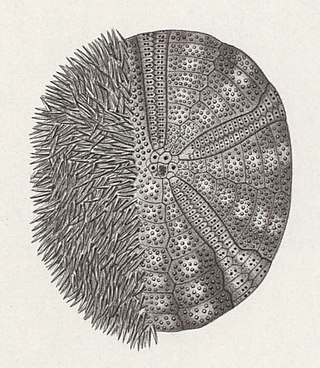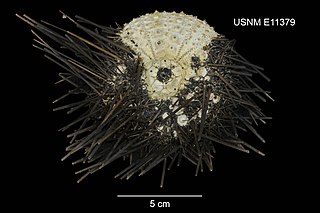
Abatus agassizii is a species of sea urchin of the family Schizasteridae. Their armour is covered with spines. It is in the genus Abatus and lives in the sea. Abatus agassizii was first scientifically described in 1889 by Georg Pfeffer.

Abatus beatriceae is a species of sea urchin of the family Schizasteridae. Their armour is covered with spines. It is in the genus Abatus and lives in the sea. Abatus beatriceae was first scientifically described in 1986 by Alberto Larrain.

Abatus cavernosus is a species of sea urchin of the family Schizasteridae. Their armour is covered with spines. It is in the genus Abatus and lives in the sea. Abatus cavernosus was first scientifically described in 1845 by Rodolfo Philippi. Females brood their young in a brood pouch through the gastrula stage until they are juveniles.

Abatus cordatus is a species of sea urchin in the family Schizasteridae. It is native to shallow seas surrounding certain island groups in the southern Indian Ocean. The body is protected by a hard test or shell which is covered with spines. The female broods its young in deep pockets on the upper surface, retaining the young in place with specialised spines. American zoologist Addison Emery Verrill first scientifically described A. cordatus in 1876.

Abatus curvidens is a species of sea urchin of the family Schizasteridae. Their armour is covered with spines. It is in the genus Abatus and lives in the sea. Abatus curvidens was first scientifically described in 1836 by Ole Mortensen.

Abatus koehleri is a species of sea urchin of the family Schizasteridae. Their armour is covered with spines. It was first scientifically described in 1908 by Koehler. It is known from the South Orkneys.

Abatus ingens is a species of sea urchin of the family Schizasteridae. Their armour is covered with spines. It is in the genus Abatus and lives in the sea. Abatus ingens was first scientifically described in 1926 by Koehler.

Abatus philippii is a species of sea urchin of the family Schizasteridae. Their armour is covered with spines. It is in the genus Abatus and lives in the oceans of the southern hemisphere. Abatus philippii was first scientifically described in 1871 by Sven Lovén.

Amphipneustes brevisternalis is a species of sea urchin. Their armour is covered with spines. It is placed in the genus Amphipneustes and lives in the sea. Amphipneustes brevisternalis was first scientifically described in 1926 by Koehler.

Amphipneustes lorioli is a species of sea urchin. Their armour is covered with spines. It is placed in the genus Amphipneustes and lives in the sea. Amphipneustes lorioli was first scientifically described in 1901 by Koehler.

Amphipneustes marsupialis is a species of sea urchin. Their armour is covered with spines. It is placed in the genus Amphipneustes and lives in the sea. Amphipneustes marsupialis was first scientifically described in 1926 by Koehler.
Amphipneustes rostratus is a species of sea urchin. Their armour is covered with spines. It is placed in the genus Amphipneustes and lives in the sea. Amphipneustes rostratus was first scientifically described in 1926 by Koehler.
Amphipneustes tumescens is a species of sea urchin. Their armour is covered with spines. It is placed in the genus Amphipneustes and lives in the sea. Amphipneustes tumescens was first scientifically described in 1926 by Koehler.
Aspidodiadema annulatum is a species of sea urchin of the family Aspidodiadematidae. Their armour is covered with spines. It is placed in the genus Aspidodiadema and lives in the sea. Aspidodiadema annulatum was first scientifically described in 1927 by Koehler.

Brissopsis parallela is a species of sea urchins of the family Brissidae. Their armour is covered with spines. Brissopsis parallela was first scientifically described in 1914 by Koehler.
Centrostephanus nitidus is a species of sea urchin of the family Diadematidae. Their armour is covered with spines. Centrostephanus nitidus was first scientifically described in 1927 by Koehler.

Centrostephanus sylviae is a species of sea urchins of the family Diadematidae. Their armour is covered with spines. Centrostephanus sylviae was first scientifically described in 1975 by Koehler.
Clypeaster amplificatus is a species of sea urchins of the family Clypeasteridae. Their armour is covered with spines. Clypeaster amplificatus was first scientifically described in 1922 by Koehler.
Clypeaster annandalei is a species of sea urchins of the family Clypeasteridae. Their armour is covered with spines. Clypeaster annandalei was first scientifically described in 1922 by Koehler.

Abatus is a genus of sea urchins belonging to the family Schizasteridae.















